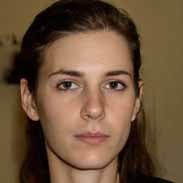Test Answers on Chapter 5 Homework – Flashcards
Unlock all answers in this set
Unlock answersquestion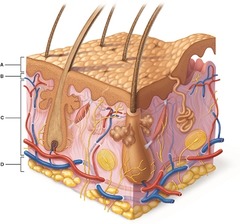
Which layer is composed primarily of dense irregular connective tissue? A) A B) B C) C D) D

answer
C
question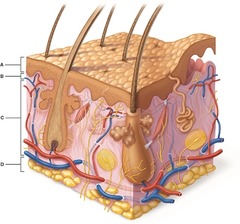
Layer B is composed primarily of __________. A) dense regular connective tissue B) simple squamous epithelium C) dense irregular connective tissue D) areolar connective tissue

answer
areolar connective tissue
question
Which of these is NOT a function of the layer at D? A) to insulate the body from heat loss B) to supply cells to replace those lost from the epidermis C) to loosely connect the skin to underlying tissue D) to store energy
answer
to supply cells to replace those lost from the epidermis
question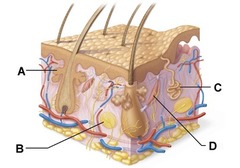
What is the function of the secretion from A? A) to lubricate hair and prevent infection B) to waterproof the epidermis C) to cool the body D) to provide nourishment for the cells in the hair

answer
to lubricate hair and prevent infection
question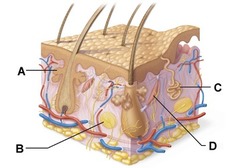
Which structure is a type of sweat gland? A) A B) B C) C D) D

answer
C
question
The skin is permeable to organic solvents, such as acetone or turpentine, because they ______. A) can dissolve the lipid bilayers of epidermal and dermal cell plasma membranes B) are small molecules that bypass skin cells and therefore directly enter the blood C) solubilize the skin's keratin filaments D) solubilize the skin's collagen fibers
answer
can dissolve the lipid bilayers of epidermal and dermal cell plasma membranes
question
The source of the fluid that accumulates in a blister is________. A) water that is absorbed from the environment into the skin B) water that is squeezed out of the overlying epidermal cells C) the plasma of the blood flowing through the numerous dermal blood vessels D) none of the above
answer
the plasma of the blood flowing through the numerous dermal blood vessels
question
During cold weather, blood vessels located in the dermis undergo vasoconstriction restricting blood flow into the skin. This produces additional body heat by routing blood to what effector organ? A) cardiac muscle B) smooth muscle C) brain D) skeletal muscle
answer
skeletal muscle
question
A Caucasian patient with pale skin is treated for low blood pressure with medication that elevates the blood pressure; however, the skin's pallor does not change. Which of the following is the most likely cause of the pallor in this patient? A) respiratory disease that results in the blood being poorly oxygenated B) the presence of hematomas in the skin C) hypertension caused by excessive use of the medication D) Anemia
answer
Anemia
question
If a large number of whiteheads appear on the skin of the forehead, which of the following would result? A) fine hairs on the forehead would become brittle B) the forehead's skin would become dry C) bacteria on the forehead's skin would grow and multiply freely D) all of the above
answer
all of the above
question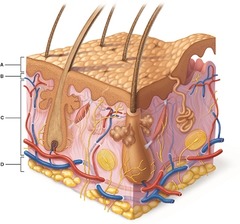
Layers B and C collectively form the _________. A) epidermis B) hypodermis C) dermis D) subcutaneous layer

answer
dermis
question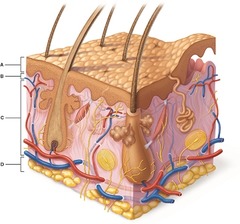
Which of the following terms describes layer D? A) epidermal B) subcutaneous C) papillary D) reticular

answer
subcutaneous
question
Which of the following correctly describes a common feature of all structures labeled A through D in the figure? A) Structures A, B, C, and D are located in the dermis. B) Structures A, B, C, and D are all various types of glands. C) Structures A, B, C, and D are composed primarily of smooth muscle. D) All the listed statements correctly describe structures A, B, C, and D.
answer
Structures A, B, C, and D are located in the dermis.
question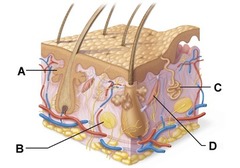
Which of these glands is properly matched with its mode of secretion? A) A; holocrine B) A; merocrine C) C; apocrine D) C; holocrine

answer
A; holocrine
question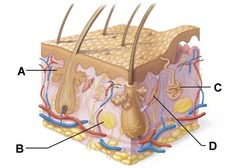
What is the function of structure B? A) production of defensive chemicals B) storage of fat C) detection of pressure stimulus D) secretion of sweat

answer
detection of pressure stimulus
question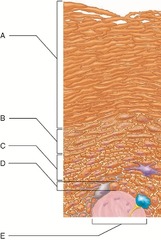
What is the most common cell type in the epidermis? A) dendritic cells B) macrophages C) keratinocytes D) fibroblasts

answer
keratinocytes
question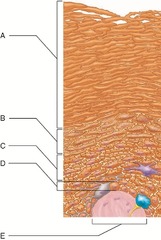
Cell division would be most common among cells in which of the labeled layers? A) A B) B C) C D) D

answer
D
question
What feature of the prickle cells in layer C causes them to have pointy projections after tissue preparation? A) the rigidity of the cell membrane B) their desmosome attachments C) glycolipids that make the layer waterproof D) pulling by shrunken keratin fibers between the cells
answer
their desmosome attachments
question
Which of these epidermal layers would be LEAST likely to develop cancer? A) A B) C C) D D) E

answer
A
question
Which of the following is NOT a layer of the epidermis? A) stratum corner B) stratum granulosum C) reticular layer D) basal layer
answer
reticular layer
question
Which of the following statements is INCORRECT? A) Keratinocytes produce a fibrous protein to protect the epidermis. B) Langerhans cells activate the immune system. C) Melanin provides protection against ultraviolet (UV) radiation. D) Tactile cells anchor the skin to the body.
answer
Tactile cells anchor the skin to the body.
question
Keratin protects skin cell DNA from the damaging effects of ultraviolet (UV) radiation. Is this statement true or false? A) True B) False
answer
False
question
Surface skin cells regenerate from stem cells found in which specific region? A) in the stratum basal B) in the stratum corner C) in the deepest layer of the skin D) in the papillary layer of the dermis
answer
in the stratum basal
question
Which of the following layers is found only on the palms of the hands or the soles of the feet? A) stratum lucid B) stratum basale C) stratum corner D) stratum granulosum
answer
stratum lucid
question
The integument's ability to resist tearing when stretched is largely due to the ________. A) desmosomes that bind together the cells of the stratum basal B) abundance of dense fibers found in the papillary layer of the dermis C) network of collagen fibers present in the reticular layer of the dermis D) dead, flattened layers of keratinized cells that fuse to form the stratum corneum
answer
network of collagen fibers present in the reticular layer of the dermis
question
Which epidermal cells act as sensory touch receptors? A) melanocytes B) dendritic cells C) tactile cells D) keratinocytes
answer
tactile cells
question
In people with lighter skin, respiratory failure can lead to a change in the color of the skin. Which pigmentation factor is affecting this change? A) carotene B) hemoglobin C) folic acid D) melanin
answer
hemoglobin
question
What is the role of the hair follicle? A) The hair follicle serves as an anchor for the hair shaft. B) The hair follicle serves as a sensory receptor. C) The hair follicle allows hair to "stand on end," or become erect. D) The hair follicle produces hair.
answer
The hair follicle serves as an anchor for the hair shaft.
question
You discover a new type of gland associated with the skin. Chemical analysis of the product shows a secretion has a pH of 4, consists of 99% water, and contains traces of normal electrolytes including urea, vitamin C, and dermicidin. There are no traces of fats or proteins. How would you classify this new gland? A) ceruminous gland B) mammary gland C) eccrine gland D) sebaceous gland
answer
eccrine gland
question
Which of the following represents a difference between eccrine sweat glands and apocrine sweat glands? A) The secretions of apocrine sweat glands contain more fat and protein than do the secretions of eccrine sweat glands. B) Eccrine sweat glands use exocytosis to make secretions, while apocrine sweat glands do not. C) Eccrine sweat glands begin to function at puberty, while apocrine sweat glands function throughout life. D) Eccrine sweat glands are located deeper in the dermis than apocrine sweat glands.
answer
The secretions of apocrine sweat glands contain more fat and protein than do the secretions of eccrine sweat glands.
question
In alopecia, new hair growth stops because cell division is inhibited in the_________. A) epithelial root sheath B) cuticle C) hair matrix D) hair follicle receptor
answer
hair matrix
question
In the presence of sunlight, Vitamin D precursors are produced. This is important for the transport of sodium in our intestines. Is this statement true or false? A) True B) False
answer
False
question
Which of the following does NOT protect the skin from bacteria? A) the low pH of the skin B) the temperature of the skin C) defense's D) cathelicidins E) dermcidin
answer
the temperature of the skin
question
Our skin helps us to regulate our body temperature by causing shivering. Is this statement true or false? A) True B) False
answer
False
question
Which of the following is NOT an immediate threat to the system as a result of burns? A) dehydration B) bacterial infection C) electrolyte imbalance D) renal failure
answer
bacterial infection
question
Which of the following would NOT be a correct characteristic of melanoma? A) diameter of 12 mm B) color that is dark black or brown C) border regularity D) asymmetry
answer
border regularity
question
Which stratum of the epidermis contains the stem cells responsible for regenerating the more superficial layers? A) stratum spinosum B) stratum corner C) stratum granulosum D) stratum basale
answer
stratum basale
question
Which type of cell is NOT found in the epidermis? A) dendritic cells B) keratinocytes C) melanocytes D) pain receptors
answer
pain receptors
question
Which dermal layer is responsible for the dermal properties of skin that are evident as cleavage lines? A) the granular layer B) the papillary layer C) the basal layer D) the reticular layer
answer
the reticular layer
question
In general, skin cancer is least likely to develop in which of the following locations? A) scalp B) forehead C) nose D) the back of the hand
answer
scalp
question
New portions of a nail are produced at the nail bed. Is this statement true or false? A) True B) False
answer
False
question
Earwax is made by __________. A) sebaceous glands B) ceruminous glands C) eccrine glands D) apocrine glands
answer
ceruminous glands
question
The most dangerous type of skin cancer is _______. A) melanoma B) basal cell carcinoma C) squamous cell carcinoma D) All of these skin cancers are equally dangerous.
answer
melanoma
question
The biggest risk factor for the development of skin cancer is excessive exposure to ultraviolet radiation from sunlight. Exposure to UV light in a tanning booth is safer. Is this statement true or false? A) True B) False
answer
False
question
Pigment can be found in several layers of the epidermis. In which layers would you expect to find the cells that produce melanin? A) stratum spinosum B) stratum lucid C) stratum granulosum D) stratum basale
answer
stratum basale
question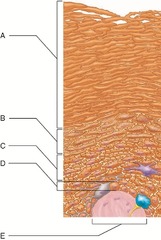
Which skin-color-associated, pigment-producing cell is located in the labeled layer D? A) fibroblast B) tactile (Merkel) cell C) keratinocyte D) melanocyte

answer
melanocyte
question
If a person were born without eccrine glands, what skin function would he or she have a hard time completing? A) metabolic function B) cutaneous sensation C) thermoregulation D) having the skin act as a physical barrier
answer
thermoregulation
question
Which skin pigment is made in the skin as a natural defense against UV radiation? A) carotene B) melanin C) keratin D) hemoglobin
answer
melanin
question
Which of the following is NOT a function of sebum? A) protection from bacteria B) lubrication of the skin C) protection from UV radiation D) prevention of water loss
answer
protection from UV radiation
question
Which glands secrete an oily product that softens the skin and hair? A) ceruminous glands B) sebaceous glands C) apocrine sweat glands D) eccrine sweat glands
answer
sebaceous glands
question
In a woman that has hirsutism, ________. A) the keratin filaments in hair undergo cell division to thicken the hair B) androgens stimulate vellus hair to become terminal hair C) the cuticles in the visible portions of hair shafts undergo extensive cell division D) none of the above
answer
androgens stimulate vellus hair to become terminal hair
question
Which of the following best explains the fact that eyebrows do NOT grow as long as the hair on the head? A) The hair follicles of the eyebrows do not have a hair matrix; the hair follicles in the scalp do have a hair matrix. B) The hair follicles of the eyebrows exhibit a resting phase, but the hair follicles in the scalp do not. C) The hair follicles of the eyebrows are active for only a few months before becoming inactive; the hair follicles in the scalp are active for years before becoming inactive. D) The hair follicles of the eyebrows are not responsive to androgens; hair follicles in the scalp are responsive to androgens. E) The hair of the eyebrows does not have a cuticle, but the hair on the head does have a cuticle.
answer
The hair follicles of the eyebrows are active for only a few months before becoming inactive; the hair follicles in the scalp are active for years before becoming inactive.
question
Susan sat out in the sun watching a baseball game. She developed small blisters on her unprotected shoulders and neck. What type of burn is represented by the formation of the blisters? A) first-degree burn B) second-degree burn C) third-degree burn D) full-thickness burn
answer
second-degree burn

